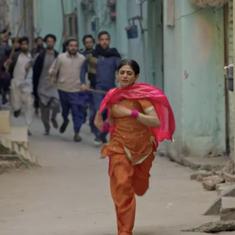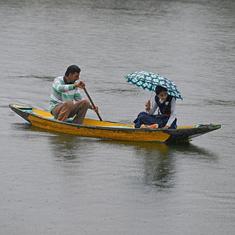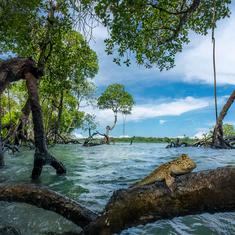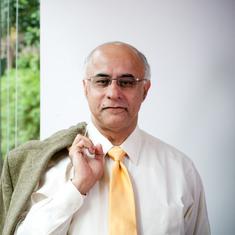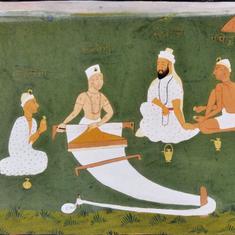About a century ago, the historian Georges Lefebvre pored over historical records dating from the late summer of 1789 in France. Here, he traced a seismic wave of panic, the “Great Fear”, when large parts of the country worried that armies of brigands were about to violently derail the French Revolution.
“Fear bred fear,” LeFebvre pronounced, outlining an archival paper trail of rumour and terrifying anxiety.
A similar paper trail exists in India, a shiver of fear detectable in archival holdings from mid-1857 through 1858, the time of the Great Uprising. Much of that archive focuses on the North Indian heartland – epicentres of the rebellion such as Delhi, Kanpur, and Lucknow.
But panic never exists within neat geographical boundaries. In places far removed from sepoy control, fear once more bred fear, with colonial authorities from Aden through Rangoon writing in tones of marked desperation.
What follows is a brief account of the Uprising in one such place rarely mentioned in the history of that momentous year: Bombay. It is an account culled from crumbling folios in the Maharashtra State Archives, which represent a tiny stratum in the overall set of records pertaining to 1857 in India. Though small, this particular paper trail nevertheless demonstrates how, in the span of weeks and months, and in one of the most secure locations in British India, imperial hubris gave way to a state of utter terror. This is a portrait of a city on edge.
Mutiny in Meerut
On May 10, 1857, sepoys in Meerut mutinied and killed several of their British officers. News of this incident reached Bombay with remarkable speed: the next day, via a telegram from Agra. By the following morning, readers of the Bombay Times digested the contents of this telegram under a headline blaring “Serious Intelligence: MUTINY AT MEERUT.” With rebels having subsequently cut telegraph lines, Bombay citizens awaited confirmation of this report via overland dak and private correspondence.
At the time, Bombay was the administrative headquarters of a vast arc of western India stretching from Karachi in the northwest to Dharwar in the southeast. Now, from across this territory, reports streamed into Bombay Castle, the nerve centre of the colonial bureaucracy, detailing alarming developments.
A deadly riot in Bharuch in May. A plot, discovered in June, to kill Europeans in Satara and Mahabaleshwar and restore the Maratha dynasty. A mutiny of the 27th Infantry in Kolhapur in July, coupled with rumblings about Bhil insurrections in Khandesh. In the eyes of many colonial officers, this smacked of a broad-based, coordinated conspiracy.
Thereafter, small events triggered all sorts of conspiracy theories. In North India, British officials had panicked over the distribution of chapatis from village to village, a supposed harbinger of revolt. Something far more prosaic caused dread and foreboding in western India: twigs. Officials in Bombay Castle lost sleep over reports of villagers near Cambay passing along bundles of the stuff.
Was it a signal for insurrection? While administrators ultimately accepted the explanation of locals—that it was a method to apprehend a common thief, whose foot imprint was the size of the twigs—they implored the Indian legislative council in Calcutta to make all systems of “carrying signs from village to village” a penal offense. Carrying twigs was now a borderline traitorous activity.

Bombay remained quiet, but the governor, Lord Elphinstone, a man once rumoured to be romantically linked to Queen Victoria, nervously apprised the strength of the European forces in the city. He counted only 200 infantrymen, with perhaps 50 or 60 additional artillerymen. Although authorities in London had dispatched thousands of troops, they would take at least two more months to arrive – perhaps longer since they were, confoundingly, being routed via the Cape of Good Hope rather than the quicker route through Egypt.
JM Shortt, commander of the garrison in Bombay, bluntly told Elphinstone that they would therefore have to rely on Indian sepoys, regardless of worries about disaffection within the ranks. “There is no choice,” he stated.
Fear bred suspicion, and suspicion hardened into a policy of repression. Soon, the jail at Thana was bursting at its seams, overcrowded with prisoners oftentimes rounded up on the flimsiest of charges. Butcher’s Island, in the harbour, housed elite detainees, such as the family of the deposed raja of Satara, believed to be involved in the conspiracy in that former princely state and in Mahabaleshwar.
The wider dragnet scooped up some curious characters, such as an Irish convert to Islam and a Jewish man from Warsaw who happened to be visiting Ratnagiri. Officials like Charles Forjett, Bombay’s ruthlessly efficient deputy commissioner of police (and a Eurasian, the offspring of an Indian mother), justified the detention of such Europeans.
He alerted his superiors to vague intelligence that parties of Europeans were “on their way to India to afford assistance to the Mutineers.” Consequently, Forjett suggested employing a “trustworthy Foreigner” to spy on and monitor the movements of any Europeans arriving in the harbor. The white man was now suspect, as well.
As paranoia spread, so did intelligence-gathering efforts. Authorities began opening and reading private correspondence, alert for any signs of sympathy for the sepoys. Some letters were flagged for almost comically absurd reasons.
A Muslim man from Aurangabad harangued a Bombay friend for not writing to him or sending him money, but was impolitic enough to include a throwaway line hoping that the forces of the Mughal emperor would soon reach the Deccan.
Other correspondence no doubt raised the hairs on the necks of eavesdropping Britons. A separate missive from Aurangabad moved quickly from commercial matters to discussion of how local Muslims planned to wage jihad and massacre Europeans during Muharram.

Educated Indians, often considered a key constituency of support for the Raj, also came under suspicion. Police infiltrated a library to monitor the conversations of Keru Luxumon Chhatre, an accomplished mathematician who later moved in the same circles as Mahadev Govind Ranade and Dadabhai Naoroji.
They also targeted Jagannath Shankarsheth, the respected Maharashtrian commercial magnate, accusing him of communicating with rebels, including Nana Saheb, one of the Uprising’s leading commanders.
As anxieties rose about a wide cross-section of the Indian population, authorities nervously eyed the religious calendar. Certain festivals had long provoked concerns about safety or communal harmony in the city. Now, they struck a decisively different form of terror in the minds of Europeans, who feared ripe moments for mass rebellion.
During Bakri Eid, in early August 1857, a “state of alarm” seized the European community, causing many families to take refuge in the Fort or on boats docked in the harbor. In Bombay Castle, British administrators recoiled at this very public expression of the vulnerability of the ruling class. “It is an evil the recurrence of which should be cautiously avoided since it serves to create the very danger that is apprehended,” declared one official.
A “large & influential body of English Gentlemen” soon convened to make sure that this did not happen again.
Muharram, however, loomed in the distance, and was a greater cause of concern, since it was, at the time, a very public occasion which brought together Hindus and Muslims. Panic once more spread throughout European quarters, forcing the hands of Elphinstone and his ministers. They devised an elaborate plan, “a chain of posts round the Native Town” – the densely-packed districts sprawling from Girgaum to Dongri – manned by police and troops, which could contain any disturbance.
Constructing this chain compelled officials to see Bombay’s geography in a stark new light, assessing positions of strength and vulnerability. One vital point, Elphinstone believed, was today’s Nana Chowk, then the site of Jagannath Shankarsheth’s house and a Parsi club house.
Elphinstone suggested placing one company of European and Indian troops here, along with a battery and guns soon to arrive from Bushire in Persia. Another strategic location was the Byculla railway station: here, Elphinstone argued, a train “would carry away the ladies & children” (of white complexion; the welfare of Indians was not factored in) while men could remain to defend the bridge over the railway line.
As Europeans counted down the days to Muharram, Bombay must have appeared as a city preparing for a siege. Shortt, the commander of the garrison, moved his troops out of the Colaba cantonment while keeping a small detachment on that island in case Indian troops rebelled.
The island was so narrow – no more than fifty yards in places – that he felt assured that a few men “could defend Colaba against an army”. At the Bori Bunder railway station – where, two decades later, work would begin on the Indo-Gothic Victoria Terminus – a train was kept “always prepared” to allow for the quick movement of soldiers. A picket guarded the foot of Malabar Hill at night.
Forjett, meanwhile, began identifying “rendezvous points,” places where Europeans could gather and seek shelter in case Muharram turned into a mutiny. Long discussions ensued, with various locations considered. Finally, the government produced neatly printed flyers, marked “Private,” which instructed Europeans on the rendezvous points in their vicinity, such as the house of William Yardley, the chief justice of the supreme court, for residents of Mahalaxmi and Breach Candy. Officials determined that Europeans in the Peninsular and Oriental Steam Navigation Company could defend their own establishment in Mazagaon, perhaps with help from the navy, although Shortt worried that sailors were “difficult to manage and to keep away from liquor.”

Muharram seemed to pass without incident. Diwali, however, nearly became explosive. Some days before the festival of lights, Forjett began spying on some sepoys. Dressed in disguise, he monitored nighttime conversations through slits in the wall of a house where they gathered. Here, he heard the sepoys discuss “the Plunder of Bombay” and acknowledge that they had originally planned to “rise and slay and plunder” during Muharram. Police soon swooped down on the sepoys and arrested them.
After a summary trial, they were condemned to be blown from the mouths of cannons.
On the day of their grisly execution, a large throng of curious onlookers gathered at the site, a corner of the Esplanade opposite today’s Metro Cinema. Amongst the crowd was one of the future founders of the Indian National Congress, Dinsha Wacha, then a 13-year-old student at the Elphinstone Institution. Fresh from afternoon classes, he watched as the convicted sepoys were chained to the cannons. Fuses were lit and commanders barked orders to fire. “The burnt flesh sent an unpleasant odour which we all could easily sniff,” Wacha recalled. “All was over.”
By this time, the worst of the panic in Bombay was over, as well. News had reached the city of the British recapture of Delhi, something which greatly soothed frayed nerves in Bombay Castle. While there were still many tense moments – in January 1858, Forjett claimed that members of the 10th and 11th Regiments were holding seditious meetings in the Native Town – the tone of correspondence in archival records began resuming their normal bureaucratic tenor.
Officials made plans to reward allies, punish suspected traitors, and disarm vast swaths of the population. A sense of imperial hubris returned.
The archival record, nevertheless, testifies to the sheer fragility of British rule in western India for a few months in 1857. One official in riot-torn Bharuch, for example, penned an emotional letter to Bombay Castle, telling his colleagues that he did not expect to survive the violence. Reports of the assassination of the magistrate of Satara, later refuted, momentarily threw into question the writ of British rule in the southern Deccan.
While records overwhelmingly provide the perspectives of ruling Britons, the voices of Indians are often audible, like the Parsis of Bharuch, who were so terrified of violence that they deliberately fed wild rumours to increase the British troop presence in the town.
Perhaps the most heartbreaking documents are petitions from Indians caught in the crossfire, claiming wrongful imprisonment and gross miscarriages of justice. Entire villages around Satara wrote to Elphinstone, accusing local British administrators of crimes and corruption.
“You have put to death the Ryots of the Southern Maratha Country without any fault on their part,” they declared. “We are prepared to die. If you wish, kill all of us now.”

Georges LeFebvre published his book, The Great Fear of 1789, in 1932. It helped pioneer a new historical perspective, one which accounted for the role of fear, panic, and rumor in human affairs. As LeFebvre pointed out, while looking at this phase of Revolutionary France, rumour regularly turned into fact, and suspicion into certainty, catalyzing a whole host of political processes.
Nor was 1789 an aberration. There were numerous other bouts of mass panic during the Revolution and afterward, as there were across eighteenth- and nineteenth-century Europe. In India, historians have identified similar episodes: “information panics” before and during the Great Uprising, periodic fears of another mutiny in the decades thereafter, and moments of mass hysteria during the Second World War.
Fear and panic remain major agents of change: simply recall the Covid-19 pandemic or survey social media-fueled conspiracy theories spread by right-wing authoritarians. In 1857, fear and panic in Bombay laid bare the brittle, ultimately ephemeral nature of the British Empire, the most powerful empire in world history.
Today, these agents have shattered political and social norms, weakened democracies, and helped hurtle us into a “post-truth” era. Old certainties have crumbled with astonishing speed.
We have left a rich archive of fear and panic for future historians to explore.
Dinyar Patel is an associate professor of history at the SP Jain Institute of Management and Research in Mumbai. His award-winning biography of Dadabhai Naoroji, Naoroji: Pioneer of Indian Nationalism, was published by Harvard University Press in May 2020.

